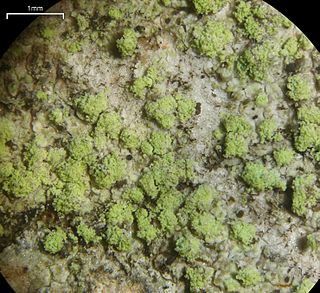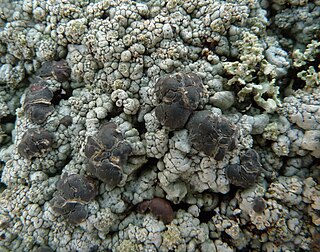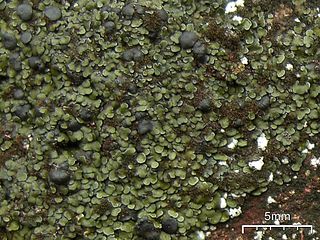
The Pannariaceae are a family of lichens in the order Peltigerales. Species from this family have a widespread distribution, but are especially prevalent in southern temperate regions.

Biatora is a genus of lichens in the family Ramalinaceae. First described in 1817, the genus consists of crustose and squamulose lichens with green algal photobionts, biatorine apothecia, colorless, simple to 3-septate ascospores, and bacilliform pycnospores. According to the Dictionary of the Fungi, the genus contains 42 species that are widely distributed in temperate areas.

Bacidina is a genus of lichens in the family Ramalinaceae. It was circumscribed by Czech lichenologist Antonín Vězda in 1990, with Bacidina phacodes assigned as the type species. Vězda included 11 species in Bacidina, which was originally classified in the Lecideaceae. These species had previously been placed in genus Bacidia.

Ochrolechia is a genus of crustose lichens in the family Ochrolechiaceae.

Trapeliopsis is a genus of lichenized fungi in the family Trapeliaceae. It contains 20 species. The genus was circumscribed in 1980 by Hannes Hertel and Gotthard Schneider, with Trapeliopsis wallrothii designated as the type species.

Trapelia is a genus of lichenized fungi in the family Trapeliaceae.
Rimularia is a genus of lichenized fungi in the family Trapeliaceae. Rimularia was circumscribed by Finnish botanist William Nylander in 1868.

Cliostomum is a genus of lichenized fungi in the family Ramalinaceae. It has about 25 species.

Lecania is a genus of lichenized fungi in the family Ramalinaceae. The genus was circumscribed by Abramo Bartolommeo Massalongo in 1853. Lecania is widely distributed, especially in temperate regions, and contains about 64 species.

Miriquidica is a genus of lichen in the family Lecanoraceae. The genus was circumscribed in 1987 by lichenologists Hannes Hertel and Gerhard Rambold, with Miriquidica complanata assigned as the type species. According to Dictionary of the Fungi, the widespread genus contains 23 species, found predominantly in arctic-alpine regions.
Sagiolechia is a genus of lichen-forming fungi in the family Sagiolechiaceae. The genus was circumscribed by lichenologist Abramo Bartolommeo Massalongo in 1854, who assigned Sagiolechia protuberans as the type species. The family Sagiolechiaceae was proposed in 2010 to contain Sagiolechia as the type genus, and genus Rhexophiale; molecular phylogenetic analysis showed that these two genera formed a distinct clade in the Ostropales.

Spilonema is a genus of lichen-forming fungi in the family Coccocarpiaceae. The genus was circumscribed by Jean-Baptiste Édouard Bornet in 1856.

Placynthium is a genus of lichen-forming fungi in the family Placynthiaceae. Members of this genus are commonly called blackthread lichens.

Fuscidea is a genus of crustose lichens in the family Fuscideaceae. It has about 40 species. The genus was circumscribed in 1972 by lichenologists Volkmar Wirth and Antonín Vězda, with Fuscidea aggregatilis assigned as the type species.

Coccotrema is a genus of lichen-forming fungi. It is the type genus of the family Coccotremataceae, in the order Pertusariales. The genus contains 16 species.

Halecania is a genus of fungi in the family Leprocaulaceae. It has 22 species. The genus was circumscribed by Austrian lichenologist Michaela Mayrhofer in 1987, with Halecania alpivaga assigned as the type species. She created Halecania to contain species, formerly placed in Lecania, with the following characteristics: uniformly amyloid apical domes, paraphyses with dark brown apical caps, and halonate ascospores.
Toensbergia is a genus of lichen-forming fungi in the family Sporastatiaceae. The genus was circumscribed by Mika Bendiksby and Einar Timdal in 2013. The genus name honours Norwegian lichenologist Tor Tønsberg, "in appreciation of his important work on sorediate, corticolous lichens". The type species is Toensbergia leucococca, which was formerly classified in genus Hypocenomyce, presumably due to its resemblance to Hypocenomyce xanthococca.
Steineropsis is a genus of lichen-forming fungi in the family Pannariaceae. It has two species. The genus was circumscribed by Toby Spribille and Lucia Muggia in 2010, with Steineropsis alaskana assigned as the type species. The type specimen of this lichen was found in Skagway, Alaska, where it was growing on a rock in a snowbed at an altitude of 1,051 m (3,448 ft). The generic name alludes to a resemblance to the genus Steinera. A second species, Steineropsis laceratula, also found in Alaska, was added to the genus in 2020. Molecular phylogenetic analysis showed that Steineropsis has a sister taxon relationship to genus Protopannaria.














